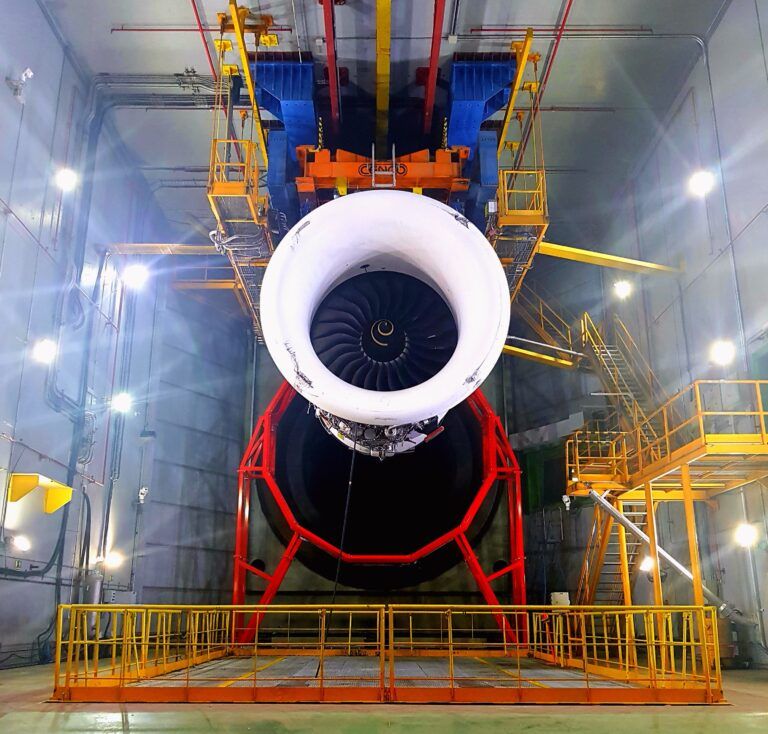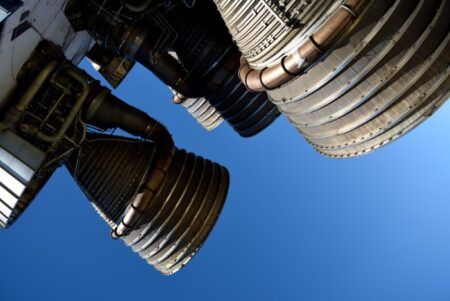Our recently published paper demonstrates a new way to measuring exhaust gas emissions from large aero-engines.
Chemical species tomography (CST) enables engineers to ‘see into’ the combustion process of any aero engine in an unprecedented way. CST tests run in 2019 and 2020 revealed the spatial distribution of CO2 in the plume of an operating Rolls-Royce Trent engine for the first time. The work provided a new window into gas turbine phenomena and aviation fuel behavior. The use of CST could help turbine combustion engineers to reduce the amount of CO2 emitted by aircraft, while ensuring other pollutant emissions such as oxides of nitrogen are minimized.
CST was first applied to a four cylinder Ford car engine in 2005. That original system was developed at the University of Manchester and provided in-cylinder images of standard retail fuel at 3,000 frames per second as it mixed with air. The CST measured the relatively broad near-IR absorption features of large hydrocarbon molecules, simultaneously on 32 beams.
But this simple spectroscopic method couldn’t work for critically important small molecules such as CO2 and carbon monoxide, which have absorption features that rise and fall over a very narrow wavelength range. At that time, Professor Walter Johnstone’s team at the University of Strathclyde had been developing sophisticated gas species measurement techniques for industrial process control using Tunable Diode Laser Absorption Spectroscopy, albeit measuring just one or two beams at a time. Hence in 2010, the Manchester and Strathclyde groups struck up a collaboration to develop CST to penetrate turbine combustion using optical techniques designed specifically for harsh environments. Other than CST, none of the various imaging methods used in piston engines could usefully be adapted to turbines.
In 2013, The University of Edinburgh and the University of Strathclyde established a strategic program to address the challenges arising, in partnership with academic groups at Manchester, Southampton, Loughborough and Sheffield. These projects also benefited from collaborations with Rolls-Royce, Siemens, Shell and specialist instrumentation partners.
Our latest paper on CO2 imaging targeted optical absorption at wavelengths around 2000nm and used 126 laser beams, each traveling 7m (23ft) in a plane perpendicular to the plume axis and situated 3m (10ft) downstream of the engine exit nozzle. The tests were run at the National Institute of Aerospace Technology’s test facility in Madrid, Spain. Typically, each test lasted a few days. However, R&D and testing of the sub-systems, and building the final system took six years. The result is that the annular combustion structure of the 18-injector Trent engine is seen to be largely maintained at the imaging plane. With this work, we can effectively ‘see’ some of the chemical detail of combustion of the different injectors in a real production aero engine, albeit downstream.
This research highlights the successful outcomes, unimaginable only 20 years ago, that can be achieved when industrial and academic partners come together to revolutionize measurement approaches. However, as with all scientific research, there is still much work to be done. In our current project, funded by the UK Engineering and Physical Sciences Research Council, we will expand the scope of CST. The £5.8 million (US$7 million) program will provide combustion process modelers with images of CO2 combined with images of temperature and carbon monoxide directly at the exit nozzle of a commercial turbine engine with 10 fuel injectors that is widely used as an auxiliary power unit, and within the combustion zone of a large-scale laboratory turbine combustion rig.





